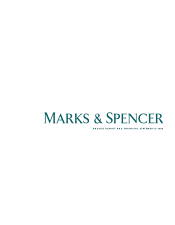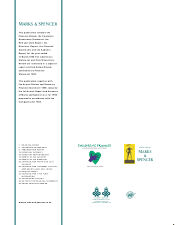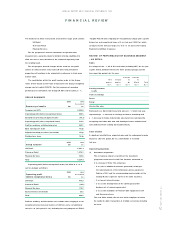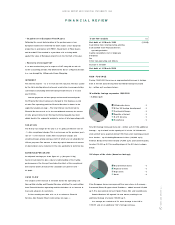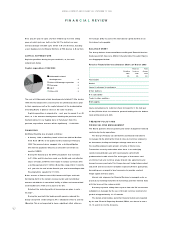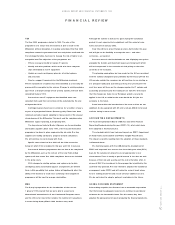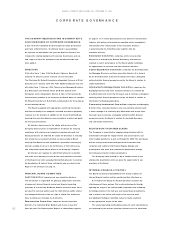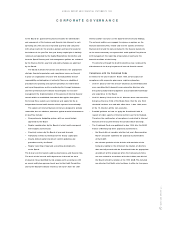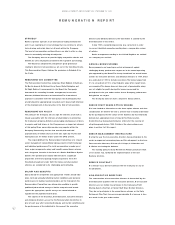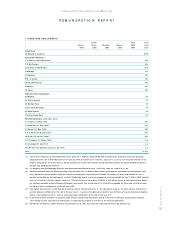Marks and Spencer 1999 Annual Report Download - page 9
Download and view the complete annual report
Please find page 9 of the 1999 Marks and Spencer annual report below. You can navigate through the pages in the report by either clicking on the pages listed below, or by using the keyword search tool below to find specific information within the annual report.
7
MARKS AN D SPEN CER p.l.c.
CO RPO RATE GO VERN AN CE
to the Board for approval.This process includes the identification
and assessment of the business and financial risks inherent in each
operating area.The process is repeated quarterly and compared
with actual results for the previous periods and latest forecasts for
the balance of the year.The four-year Group capital plan is similarly
reviewed and updated by the Capital Expenditure Committee and
then the Board.Treasury and risk management policies are reviewed
by the finance director quarterly and policy changes are approved
by the Board.
The Board maintains full control and direction over appropriate
strategic, financial, organisation and compliance issues, and has put
in place an organisation structure with formally defined lines of
responsibility and delegation of authority.There are established
procedures for planning and capital expenditure, for information
and reporting systems, and for monitoring the Group’s businesses
and their performances.The Board has delegated to executive
management the implementation of the systems of internal financial
control within an established framework that applies throughout
the Group;these systems are monitored and supported by an
independent internal audit function which operates internationally.
The systems of internal financial control are designed to provide
reasonable, but not absolute, assurance against material misstatement
or loss.They include:
– Comprehensive budgeting systems with an annual budget
approved by the Board
– Regular consideration by the Board of actual results compared
with budgets and forecasts
– Q uarterly reviews by the Board of year-end forecasts
– H alf-yearly reviews by the Board of the Group capital plan
– Clearly defined capital investment control guidelines and
procedures set by the Board
– Regular reporting of legal and accounting developments
to the Board.
The Group’s control systems address key business and financial risks.
The work of the internal audit department is focused on areas
of greatest risk as identified by risk analysis and in accordance with
an annual audit plan approved each year by the Audit Committee
and by the Board.The Board receives a full report from the chief
internal auditor each year on the department’s work and findings.
The external auditors are engaged to express an opinion on the
financial statements.They review and test the systems of internal
financial control and the data contained in the financial statements
to the extent necessary to express their audit opinion.They discuss
with management the reporting of operational results and the
financial condition of the Group.
The directors, through the Audit Committee, have reviewed the
effectiveness of the Group’s systems of internal financial control.
Compliance with the Combined Code
In relation to the year ended 31 March 1999, certain aspects of
compliance with corporate governance require explanation:
• Until 31 January 1999 the roles of Chairman and Chief Executive
were combined but balanced by non-executive directors who
bring strong independent judgement and considerable knowledge
and experience to the Board.
• Until 31 January 1999, six of the 21 directors were non-executive,
being less than one third of the Board. Since then the one third
threshold has been met and with effect from 1 June 1999, seven
of the 16 directors will be non-executive.
• Detailed guidance on how to apply the Combined Code in
respect of wider aspects of internal control is yet to be finalised.
Therefore the confirmation of compliance is restricted to internal
financial control as permitted by the London Stock Exchange.
• The Combined Code was published in June 1998 after the AGM
N otice of Meeting had been approved and therefore:
• the Board did not consider whether last year’s Remuneration
Report should be submitted for approval by shareholders
at that AGM;
• the relevant provision of the Articles of Association of the
Company relating to the retirement by rotation of directors
does not fully accord with the Combined Code.An appropriate
amendment will be proposed when the Company’s Articles
are next revised. In accordance with the Articles, one third of
the Board retired by rotation at the 1998 AGM.This included
one director, Paul Smith, who had been in office for four years.
ANNUAL REPORT AND FIN ANCIAL STATEMENTS 1999

